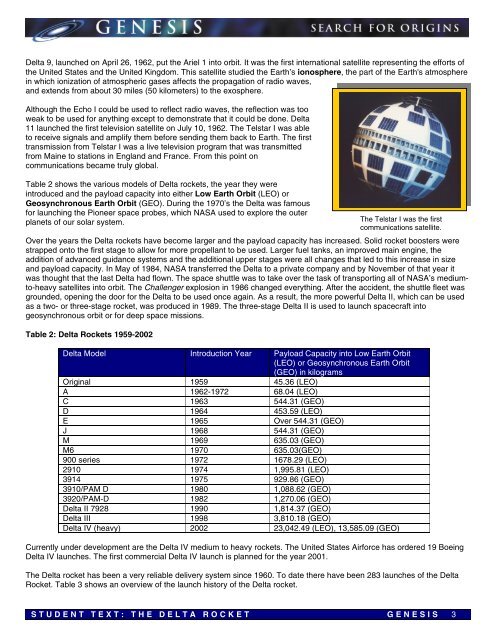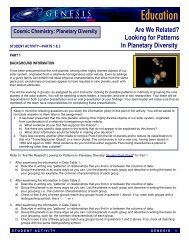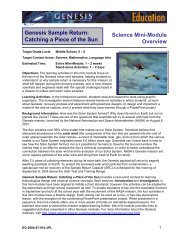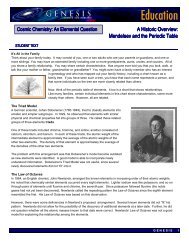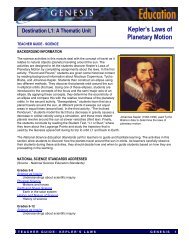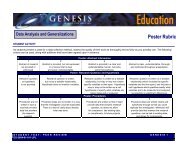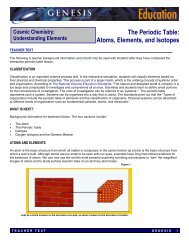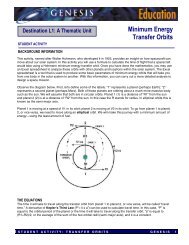Genesis Launch Vehicle: The Delta Rocket - Genesis - NASA
Genesis Launch Vehicle: The Delta Rocket - Genesis - NASA
Genesis Launch Vehicle: The Delta Rocket - Genesis - NASA
Create successful ePaper yourself
Turn your PDF publications into a flip-book with our unique Google optimized e-Paper software.
<strong>Delta</strong> 9, launched on April 26, 1962, put the Ariel 1 into orbit. It was the first international satellite representing the efforts of<br />
the United States and the United Kingdom. This satellite studied the Earth’s ionosphere, the part of the Earth's atmosphere<br />
in which ionization of atmospheric gases affects the propagation of radio waves,<br />
and extends from about 30 miles (50 kilometers) to the exosphere.<br />
Although the Echo I could be used to reflect radio waves, the reflection was too<br />
weak to be used for anything except to demonstrate that it could be done. <strong>Delta</strong><br />
11 launched the first television satellite on July 10, 1962. <strong>The</strong> Telstar I was able<br />
to receive signals and amplify them before sending them back to Earth. <strong>The</strong> first<br />
transmission from Telstar I was a live television program that was transmitted<br />
from Maine to stations in England and France. From this point on<br />
communications became truly global.<br />
Table 2 shows the various models of <strong>Delta</strong> rockets, the year they were<br />
introduced and the payload capacity into either Low Earth Orbit (LEO) or<br />
Geosynchronous Earth Orbit (GEO). During the 1970’s the <strong>Delta</strong> was famous<br />
for launching the Pioneer space probes, which <strong>NASA</strong> used to explore the outer<br />
planets of our solar system.<br />
<strong>The</strong> Telstar I was the first<br />
communications satellite.<br />
Over the years the <strong>Delta</strong> rockets have become larger and the payload capacity has increased. Solid rocket boosters were<br />
strapped onto the first stage to allow for more propellant to be used. Larger fuel tanks, an improved main engine, the<br />
addition of advanced guidance systems and the additional upper stages were all changes that led to this increase in size<br />
and payload capacity. In May of 1984, <strong>NASA</strong> transferred the <strong>Delta</strong> to a private company and by November of that year it<br />
was thought that the last <strong>Delta</strong> had flown. <strong>The</strong> space shuttle was to take over the task of transporting all of <strong>NASA</strong>’s mediumto-heavy<br />
satellites into orbit. <strong>The</strong> Challenger explosion in 1986 changed everything. After the accident, the shuttle fleet was<br />
grounded, opening the door for the <strong>Delta</strong> to be used once again. As a result, the more powerful <strong>Delta</strong> II, which can be used<br />
as a two- or three-stage rocket, was produced in 1989. <strong>The</strong> three-stage <strong>Delta</strong> II is used to launch spacecraft into<br />
geosynchronous orbit or for deep space missions.<br />
Table 2: <strong>Delta</strong> <strong>Rocket</strong>s 1959-2002<br />
<strong>Delta</strong> Model Introduction Year Payload Capacity into Low Earth Orbit<br />
(LEO) or Geosynchronous Earth Orbit<br />
(GEO) in kilograms<br />
Original 1959 45.36 (LEO)<br />
A 1962-1972 68.04 (LEO)<br />
C 1963 544.31 (GEO)<br />
D 1964 453.59 (LEO)<br />
E 1965 Over 544.31 (GEO)<br />
J 1968 544.31 (GEO)<br />
M 1969 635.03 (GEO)<br />
M6 1970 635.03(GEO)<br />
900 series 1972 1678.29 (LEO)<br />
2910 1974 1,995.81 (LEO)<br />
3914 1975 929.86 (GEO)<br />
3910/PAM D 1980 1,088.62 (GEO)<br />
3920/PAM-D 1982 1,270.06 (GEO)<br />
<strong>Delta</strong> II 7928 1990 1,814.37 (GEO)<br />
<strong>Delta</strong> III 1998 3,810.18 (GEO)<br />
<strong>Delta</strong> IV (heavy) 2002 23,042.49 (LEO), 13,585.09 (GEO)<br />
Currently under development are the <strong>Delta</strong> IV medium to heavy rockets. <strong>The</strong> United States Airforce has ordered 19 Boeing<br />
<strong>Delta</strong> IV launches. <strong>The</strong> first commercial <strong>Delta</strong> IV launch is planned for the year 2001.<br />
<strong>The</strong> <strong>Delta</strong> rocket has been a very reliable delivery system since 1960. To date there have been 283 launches of the <strong>Delta</strong><br />
<strong>Rocket</strong>. Table 3 shows an overview of the launch history of the <strong>Delta</strong> rocket.<br />
STUD ENT TE XT: TH E DELTA RO CK ET<br />
G E N ESI S<br />
3


